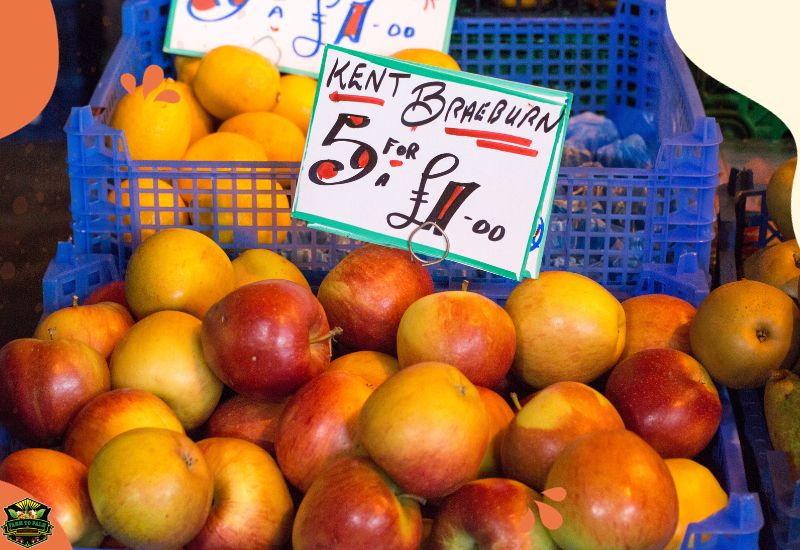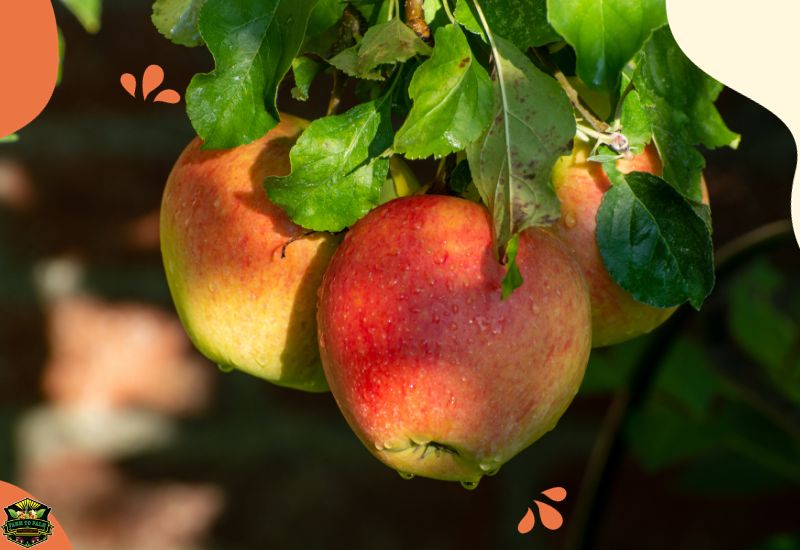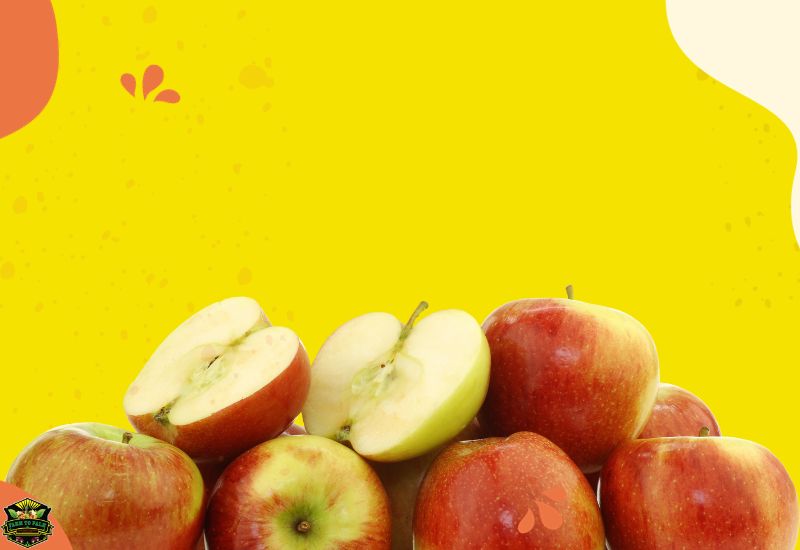Discover the fascinating story of the Braeburn Apple, from its origins in New Zealand to its rise as one of the top 5 apple varieties produced in Washington, USA.
Learn about its exceptional flavor, versatility, and global impact as one of the most important commercial apple varieties. Whether you’re a fan of delicious, juicy apples for snacking or baking, this article is a must-read for all apple enthusiasts!
Origins and History
Braeburn apples are initially from New Zealand and were discovered by a grower named O. Moran in 1952. He found the apples growing as a chance seedling in Upper Moutere, near Nelson on the South Island.
After realizing they differed from any other varieties he knew, Moran brought them to Williams Brothers Nursery.
The nursery identified it as a new variety and started growing it commercially at Braeburn Orchards. Although its parentage was initially unknown, a study in 2020 revealed that Sturmer’s Pippin and Delicious apples were its parents, with Lady Hamilton being a sibling variety.

Braeburn apples are known for their rich flavor and are used in modern apple breeding, giving rise to popular apples like Jazz, Kanzi, Envy, and Sweetie.
While these new varieties have better disease resistance and are replacing Braeburn apples in some markets, Braeburn apples are still commercially grown in warm to temperate regions worldwide, including New Zealand, Australia, the United Kingdom, France, Italy, Chile, Canada, and the United States, especially in Washington State.
You can find Braeburn apples in season at grocers, farmer’s markets, and nurseries for home garden planting.
What does a Braeburn Apple look like?

Braeburn apples are small to medium-sized, about 6 to 7 centimeters in diameter. They have a round to conical shape with flat shoulders, a broad middle, and a slightly tapered base.
Some may have slanted shoulders and ribbing, and their skin is thin but tough, resistant to bruising. The surface is mostly matte with a yellow-green base covered in large red-pink blush and striping patches. The blush intensity varies based on where they’re grown.
Underneath the skin, the flesh is firm, coarse-grained, and juicy with a crispy consistency. It encases a sizeable central core with tiny dark brown seeds.
What do Braeburn Apples taste like?

Braeburn apples have a balanced, sweet, and sharp taste with a refreshing flavor that’s not too sugary or tart. They also have a rich, cider-like undertone with hints of cinnamon, nutmeg, pears, and citrus.
When are Braeburn Apples in season?

Braeburn apples are usually harvested in mid-autumn in regions where they are grown. They are considered late-season apples, with North American harvests from September to October and European crops from October to November. In their native New Zealand, Braeburn apples ripen in late March to April, while those grown in Chile ripen in June.
Braeburn Apple Nutrition Facts

Braeburn apples are packed with essential nutrients that are great for your body. They contain fiber to keep your digestive system in check, potassium to help maintain a healthy fluid balance, and calcium for building strong bones and teeth.
They also provide vitamin C to boost your immune system, vitamin A for organ health, and vitamin E to fight inflammation.
Additionally, they contain essential minerals like copper, zinc, magnesium, manganese, and phosphorus. The red color of the apple skin indicates the presence of anthocyanins, which are natural antioxidants that protect your cells from damage caused by free radicals and oxidative stress.
See the table below for in depth analysis of nutrients:
Nutritive value per 100 g,
| Nutrient | Amount | Daily Value |
|---|---|---|
| Energy | 50 Kcal | 2.5% |
| Carbohydrates | 13.81 g | 11% |
| Protein | 0.26 g | 0.5% |
| Total Fat | 0.17 g | 0.5% |
| Cholesterol | 0 mg | 0% |
| Dietary Fiber | 2.40 g | 6% |
| Vitamins | ||
| Folates | 3 µg | 1% |
| Niacin | 0.091 mg | 1% |
| Pantothenic acid | 0.061 mg | 1% |
| Pyridoxine | 0.041 mg | 3% |
| Riboflavin | 0.026 mg | 2% |
| Thiamin | 0.017 mg | 1% |
| Vitamin A | 54 IU | 2% |
| Vitamin C | 4.6 mg | 8% |
| Vitamin E | 0.18 mg | 1% |
| Vitamin K | 2.2 µg | 2% |
| Electrolytes | ||
| Sodium | 1 mg | 0% |
| Potassium | 107 mg | 2% |
| Minerals | ||
| Calcium | 6 mg | 0.6% |
| Iron | 0.12 mg | 1% |
| Magnesium | 5 mg | 1% |
| Phosphorus | 11 mg | 2% |
| Zinc | 0.04 mg | 0% |
| Phyto-nutrients | ||
| Carotene-ß | 27 µg | — |
| Crypto-xanthin-ß | 11 µg | — |
| Lutein-zeaxanthin | 29 µg | — |
ORAC value: 5900 Source: USDA National Nutrient data base
What to make with Braeburn Apples?

- Braeburn apples have a balanced, sweet-tart flavor perfect for fresh and cooked preparations.
- They can be enjoyed independently, slightly chilled, or at room temperature.
- You can use them in green salads, slaws, or appetizer platters with soft and creamy cheeses like brie, white cheddar, or camembert.
- They make an excellent topping for breakfast dishes and can be served in parfaits or layered into sandwiches for added crunch.
- Braeburn apples hold their shape well and are ideal for baked goods like tarts, muffins, crumbles, and scones when cooked.
- They can also be used in purees, sauces, jams, and jellies, roasted with root vegetables, or cooked and served over meat dishes.
- Additionally, they can be pressed into juice and used in cider blends, cocktails, and sparkling beverages.
- Braeburn apples pair well with spices like nutmeg, ginger, cloves, cinnamon, vanilla, salted caramel, maple syrup, and meats such as pork, turkey, and poultry.
- They also complement fruits like blackberries, blueberries, strawberries, citrus fruits, and peaches.
- To store them, place whole, unwashed Braeburn apples in the refrigerator’s crisper drawer for up to one month. They will also be kept in cold cellars for two to four months and in professional storage for up to eight months.
- They can also be dried or frozen for extended use.
Why can’t I find Braeburn Apples anymore?

In today’s fast-paced world of apples, the classic Braeburn apple faces the risk of becoming obsolete. Compared to modern apples, Braeburn lacks consistency and is prone to issues like Braeburn Browning Disorder caused by higher internal carbon dioxide levels.
As a result, breeders have been searching for Braeburn descendants that can replace it and be sold for profit. The new apple varieties Envy, Jazz, Sweetie, and Kanzi overshadow the pioneering Braeburn, making it difficult to find space for Braeburn on grocery store shelves despite its significant contributions to the apple industry.
Tips for buying Braeburn apples

Braeburn apples are typically available at select grocery stores, specialty markets, and directly from orchardists during harvest. They are known for their large size, and each pound of Braeburn apples contains about two whole apples, each weighing approximately 1/2 pounds.
At the grocery store, Braeburn apples generally cost around $2 per pound, which makes each apple approximately a dollar. The best prices are usually found right after the harvest season, which occurs between October and May.
If you need help finding Braeburn apples at your local grocery store, it might be because newer varieties related to Braeburn have taken their place. Consider trying modern offspring varieties like Jazz Apples, Envy Apples, or Kanzi Apples to substitute the traditional Braeburn type.
Long-term apple storage
When storing Braeburn apples, choosing ones without blemishes, bruises, or damage is essential. Look for nearly ripe, intact apples, which will keep the best. Handle them carefully to avoid causing any damage or bruising.
You can store Braeburns in the crisper drawer of a refrigerator for about 1 month, in a cold room or cellar for 2-4 months, and in commercial controlled-atmosphere storage for 8-10 months.
How to Store a Braeburn Apple and Keep It Fresh

To keep a Braeburn apple fresh for up to 6 weeks, store it in the refrigerator at a temperature of 30-35°F with high humidity.
Alternatively, wrap the apple in a damp towel or place it in a plastic bag with holes before refrigerating.
Another method is to store the apple in a paper bag with an orange or other citrus fruit.
If you’re not using a refrigerator, keep the apple with other apples in a cool, dark place.
Add a slice of lemon and some cinnamon sticks to the storage container to extend its lifespan.
Conclusion
The Braeburn apple is a delicious and popular variety known for its crispy texture and sweet flavor. You can purchase Braeburn apples at Farm to Palm supermarket or the app store. Whether you enjoy them raw or with peanut butter, they make for a delightful snack. Take advantage of the opportunity to savor this excellent apple variety!

